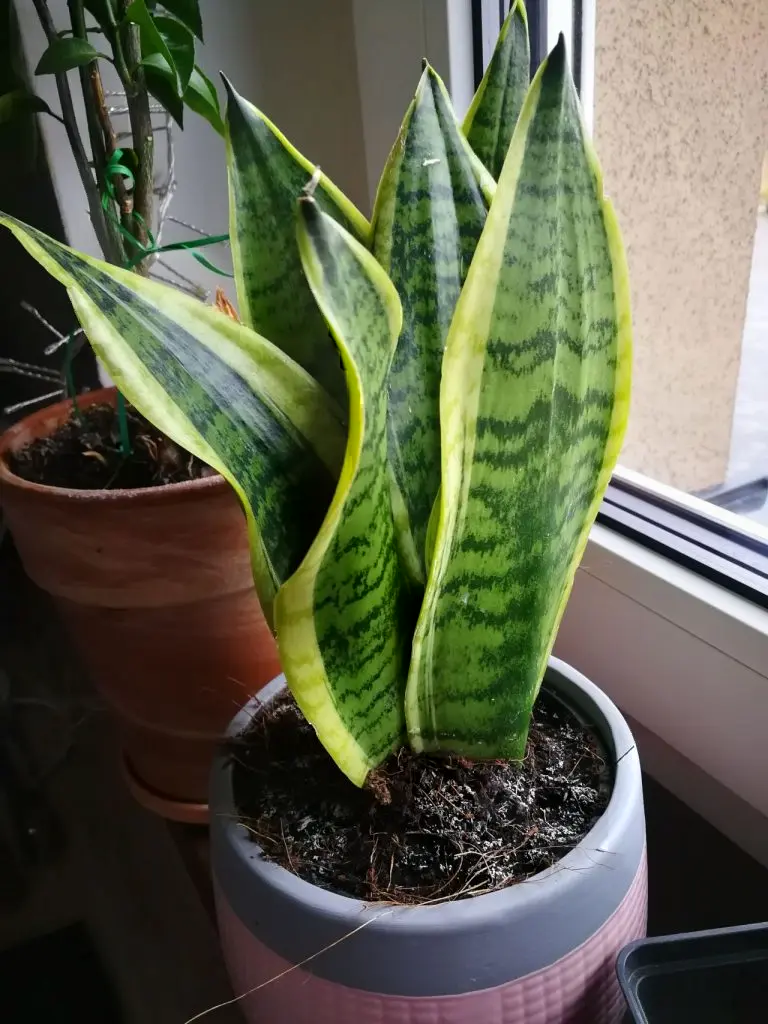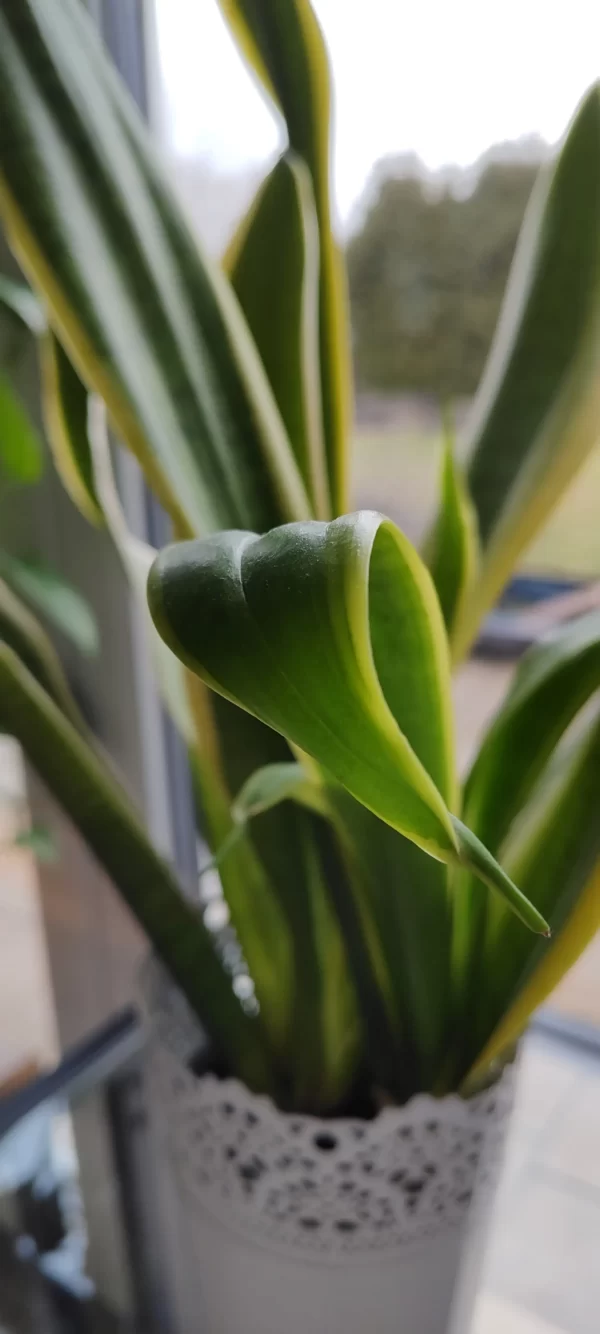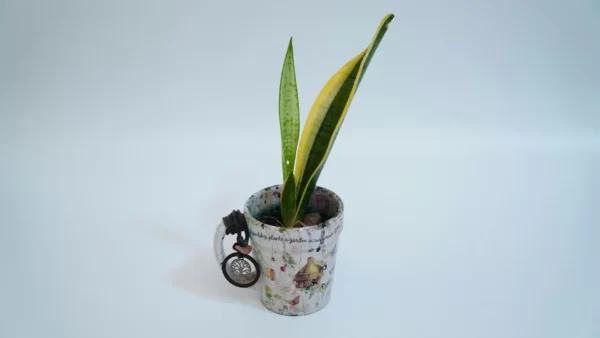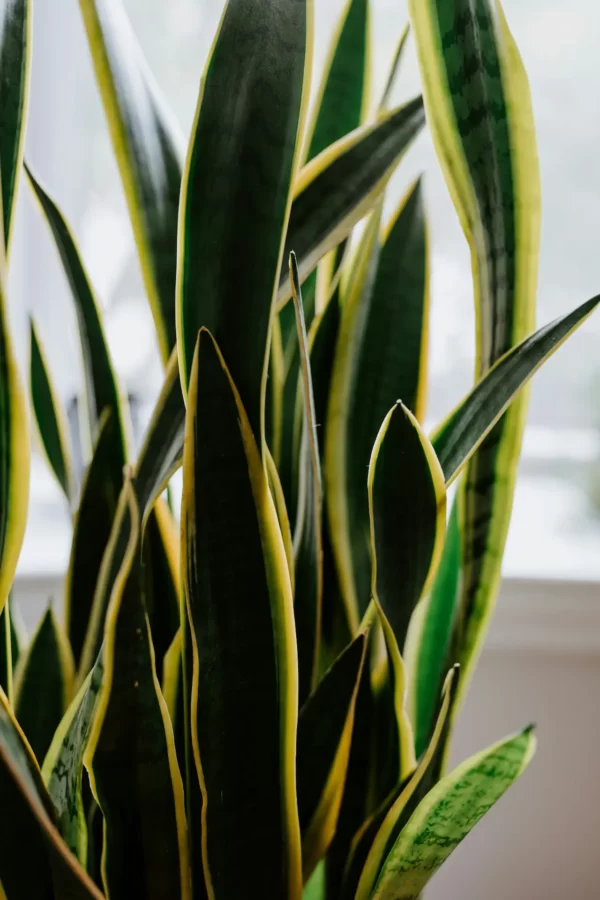Snake Plant (Sansevieria trifasciata) – cultivation and care
Today I would like to show you another wonderful succulent that grows on my windowsill. Snake plant is a very interesting succulent that I have seen quite often in my offices.
No wonder, because it is one of the easiest succulents I have dealt with.
Snake Plant has amazing green leaves that curl distinctively. A bright border adds charm to them, right at the edge of the leaves, which makes the leaves a bit like swords pointing upwards.
Decorates the interior nicely and fits perfectly with the pots stretched upwards and additionally has many interesting health properties.
But more on that in a moment.
First, some basic information about this succulent.
Snake plant – basic information
| Botanical Name: | Sansevieria trifasciata |
| Plant type: | succulent |
| Popular Names: | mother-in-law’s tongue, the sword of St. George, the coil |
| Earth: | pH 6.6 – 7.5 permeable |
| Flower: | White |
| Origin: | South Africa |
- Partial sunlight
- Typical watering of succulents
- For home growing
- The minimum temperature is -1.1 degrees Celsius
- Propagation by suckers
- It grows to about 120 cm in height
- May be toxic to dogs and cats
Sansevieria trifasciata comes from West Africa and has been cultivated on our continent for several hundred years.
Like aloe and other species of succulents, it can be easily grown in our homes, but you have to remember how to care for succulents.
Sanseveria trifasciata has amazing green leaves in which, like any succulent, it stores water. Today, we most often meet snake plants in offices, which is a pity, because it is a great decoration for houses, and also minimalist.
I like it the most in the composition with a white pot and white stones, pebbles … preferably thick, with smooth edges.
You can create a leaf wall to separate rooms.
However, great looks are not everything.
Sanseveria also has many health benefits that people often forget.
We live in a constant rush and we forget that our natural environment is not concrete, but green and plants. I think it is worth combining wonderful plants that not only decorate the interior but also contribute to our health.
A snake plant, like an orchid, is a plant that cleans the air. I recommend it especially for the bedroom because this is how it will work best. Pay attention to how much time we spend on sleep and how little importance people attach to the environment in which they rest.
We have concrete, plaster, glue, wallpaper and the like everywhere, and yet the natural environment of man is nature. We need fresh air to live, so I encourage you today – place a few plants in the bedroom, such as Sansevieria trifasciata or other succulents that clean the air.
I don’t know if you know, but aloe creates oxygen molecules even at night.
Wouldn’t it be nice to have it in the bedroom?
Think about it, but before you decide, read a few more lines about sansevieria and how to grow it.
Sansevieria breeding at home

If you decide to breed sansevieria at home, I am sure that it will bring you a lot of joy and fulfilment.
The best place for sansevieria in your home will be bright rooms, preferably near a north window.
Like other succulents, sansevieria loves a lot of light, but if it is exposed to direct sunlight for too long, the edges of its leaves may turn yellow.
The best solution is curtains that do not darken the room but only diffuse the sun’s rays, ensuring the right amount of daylight in the room.
If you plan to place sansevieria on the windowsill, pay attention to the tightness of the windows. If you are ventilating the rooms, you have air vents or you just do a micro tilt, it is better to move the sansevieria to another place.
Of course, this only matters in winter, but sometimes we forget about such things when looking for the best place for our plants.
Especially if we do it in summer, enjoying the great weather.
Sansevieria does not tolerate temperatures below 10 degrees Celsius, so it will feel great in an average apartment with a temperature of around 21 degrees.
Sanseveria trifasciata – Propagation
Sansevieria can be propagated in several ways.
The most popular method of propagation is by separating shoots from the main part of the plant. To do this, you need to take the plant out of the pot, clean it from the soil and cut off the regrowth with a sharp knife.
The regrowth must have its root system. Of course, we can only find out about it when we dig the plant out of the ground … unfortunately. So if, after digging, you see a regrowth with its roots, you have a much better chance that the plant will survive the separation.
If you are in doubt as to what this looks like, check out my post on How to Replant Aloe Vera. There are step-by-step photos of my aloe regrowths.
Snake plant propagation from the leaf

This method of propagating sansevieria is a bit more difficult, but it is worth mentioning.
The first thing you need to do is choose the right leaf to cut.
In this way, you can make good use of leaves that have been damaged and are suitable for removal.
So cut off the leaf and let it dry for a few days. The drying time depends on the size of the cut leaf, but it should not be too long. Two to three days is enough because Sanseveria is not a succulent plant that is too “juicy”.
As a result, it will dry quickly and will be suitable for planting over and over again.
The dried leaf should be cut into smaller pieces, which should be about 6-7 cm in size.
And here we come to a very important moment – when cutting a leaf, pay attention to which tip was closer to the ground.
The point is, you can’t put the leaves back into the soil differently than they grew before they were cut.
If you turn them over, they will rot!
But do not worry. It is enough to arrange the leaves in such a way as to see how they grew and after the problem.
This is how we approach planting sansevieria in the ground. Before you do that, however, be sure to use the rooting agent.
You can buy it in virtually any garden store or on Amazon.
Dip the cut leaves in water and then in the rooting agent. Fill the pot with soil intended for cacti and water it generously.
Once the water has soaked into the ground, it’s time to plant sansevieria. Place the leaves in the ground with the appropriate side and leave for a few weeks.
One more thing. Pay attention to the soil you plan to use for planting succulents. If you have any doubts, check out my guide in which I describe the best soil for aloe vera. The same principles of land preparation apply to other succulents as sanseveria.
So much for the leaf propagation of sansevieria. now you have to wait, watering only when the soil is completely dry.
Watering snake plant
Watering Snake Plant is not difficult. Like Echeveria and Aloe Vera, it requires moderate watering.
As with other succulents, allow the soil to dry completely before watering the plant.
If sansevieria grows in a pot that stands on a stand, be sure to pour out any excess water that may accumulate in it after watering.
Never let the succulent stand in the water as its roots will start to rot and the plant may not survive this.
In summer we water sansevieria approximately every 1-2 weeks. Winter, in turn, is the period when the plant is resting, so you can increase the frequency of watering to 3 or even 4 weeks.
The humidity of the air in the room has a great influence on the frequency of watering.
Watering itself should be done using a watering can, directly on the ground where the plant grows. Do not spray or sprinkle sansevieria.
Fertilizing sanseveria
Snake plants should be fertilized, but it must be done carefully.
All succulents are used to grow in very harsh conditions, in which the soil is not very fertile.
This does not mean, however, that they will grow without nutrients, so you need to provide the right amount.
In summer, sansevieria should be fertilized approximately every 3 weeks.
A liquid fertilizer intended for succulents is best suited for this, but you should be careful with the dosage.
I recommend using doses half the amount indicated on the packaging by the manufacturer.
This way you will not overdo it.
However, if sansevieria receives too much fertilizer, you can tell by its leaves, which start to tip over instead of “standing at attention” ?
Sansevieria flower
Sansevieria flowers enchant you at the beginning of summer.
They grow out of the ground right next to the plant and have a really interesting shape. I like the way they curl up the most ? Charming …
Interestingly, sansevieria most often blooms when it is subjected to moderate stress. This usually happens when the pot is too small and the roots start to tangle. It starts to bloom completely unexpectedly and smells beautiful at the same time.
Sometimes it attracts pests that are attracted by this interesting smell, so pay attention to what is crawling on your sansevieria.
After flowering, the inflorescence must be removed as it becomes unusable.
Unfortunately, I do not have photos of my coil, but I will certainly complete this article as soon as it blooms.
Exaggeration
I replant the snake plant every few years. You don’t need to rush to transplant, because sansevieria likes to be wrapped in a pot.
As a rule, I only plant three or four-year-old plants. Then I transfer them to a larger pot, in which I have specially prepared soil for succulents.
You can prepare it yourself or buy a ready-made mixture at a garden store.
Remember to choose the right pot for transplanting. It should be one size larger than the previous one.
Spring is the best time to replant and winter is the worst. Then the plant is dormant and may not take it very well.
Sansevieria trifasciata – properties
I must admit that I am one of the doubters …
I like to know but I try to check the sources of my information and I do not like superficial opinions about the health properties of various plants.
In writing this article, I began to look at scientific sources that could support theories about the health benefits of sansevieria.
And this is how I found research that I found in the National Library of Medicine of the United States.
I encourage you to read the article yourself, but at the end, we can read that:
The results obtained show that the extracts have a moderately dose-dependent analgesic effect on the various pain models used. Both extracts exerted a strong inhibitory effect on the mouse torsion test (test useful for the evaluation of mild analgesic NSAIDs).
Analgesic and Antipyretic Effects of Sansevieria Trifasciata Leaves
Jeba Sunilson J Anbu , P Jayaraj , R Varatharajan , John Thomas , James Jisha , and M Muthappan
The translation comes from uncle google, so it may be a bit incoherent but the results themselves are quite interesting because I knew only the beneficial properties of air purification.
In the course of my research, I also found the results of research on arterial hypertension and the positive effect of sansevieria on the rats that were tested.
I will certainly observe this topic as a lover of healthy eating. The progress is very interesting, but at the moment we have to be content with setting sansevieria in our home and enjoying the eyes because it is probably not yet sufficiently documented and the full spectrum of effects on humans is unknown.
Let’s get back to air purification.
As I mentioned earlier, I do not like stories and I trust research results much more.
While looking for evidence of the cleansing properties of sansevieria, I came across the results of NASA’s 1989 research.
I have to say that my backhoe fell a bit, so the more readily I read these results, because why would NASA test sansevieria?
I must admit that only when I read these results did I realize how different challenges are faced by people who travel into space.
People responsible for research, incl. sansevieria have studied and proven the level of air purification by various plants including sansevieria.
Scientists built a plexiglass chamber in which they placed the plants. The leakage level was constantly monitored with the use of appropriate equipment. Then various substances were injected into the chamber, including formaldehyde, benzene and other toxins.
The air in the chamber was checked every 6 hours and then plant samples were taken to see if harmful substances had penetrated the plants.
I will not write about the entire article, I encourage you to open it yourself on page 10 (page 18 pdf) and look at table 2.
It shows that with a total area of 2,871 cm2, the mother-in-law’s tongue removed 28,710 micrograms of benzene in 24 hours. It is not the best result compared to other plants, but also not the worst.
The point is not whether the mother-in-law’s tongue is the best plant to purify the air, but that there is scientific evidence that is available today that proves that it has a cleansing effect at all.
You know …
I don’t want to write like many people, repeating the same thing over and over without understanding. I want to be sure that what I am writing is true!
And this time it is so.
Below in the sources, I put a link to the document in PDF format directly from the NASA website.
It’s worth reading.
That’s it for today …
I am going back to preparing my concrete pots which I have been creating for several weeks.
I will share my achievements in the next post.
Regards and to the next ?
dreams
Sources
Wolverton BC; Johnson A; Bounds K, 1989. Interior landscape plants for indoor air pollution abatement. Final Report. Interior landscape plants for indoor air pollution abatement. Final Report., USA: National Aeronautics and Space Administration (NASA), John C. Stennis Space Center.
Sansewieria gwinejska – Wikipedia
Analgesic and Antipyretic Effects of Sansevieria Trifasciata Leaves





